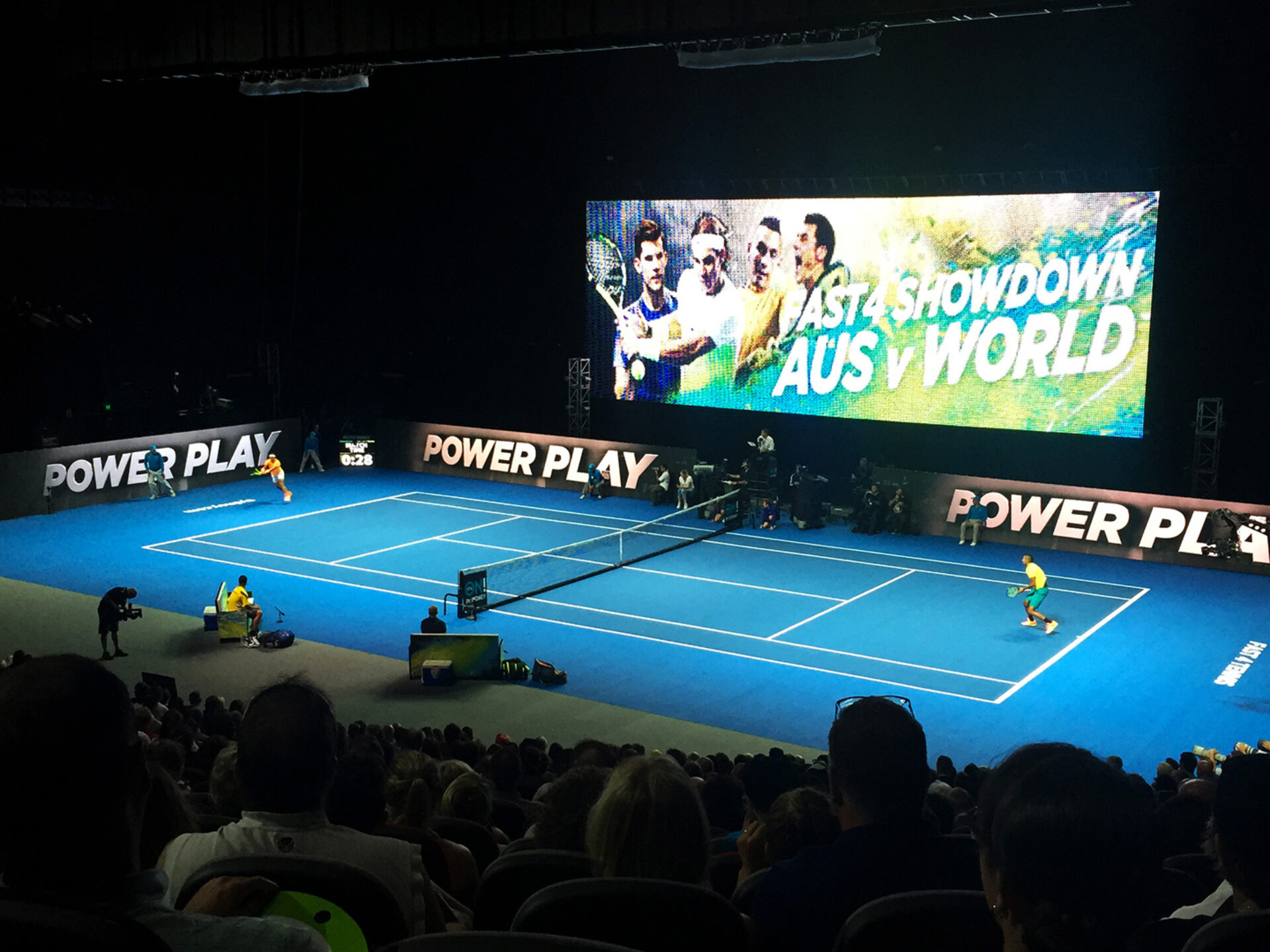January 26, 2017
Australia Serves up New Year Tennis Twist

The New Year sees Australia welcome the world’s biggest names in tennis.
Along with playing host to Internationals and the season’s first Grand Slam, Australia is among the countries showcasing new tennis formats at some unexpected venues.
As a tennis fan, January in Australia is pretty hard to beat.
Thousands of us flock to pro tournaments in the nation’s capital cities, and to see tennis’ superstars contest Melbourne’s Grand Slam event – the Australian Open.
In recent years, extra buzz has been created by additional events like Fast4, played at a brand new venue this year – the world class ICC Sydney Theatre, in Darling Harbour, designed by joint venture partners HASSELL + Populous. The full house in Sydney were entertained as the World Team of Nadal and Thiem ultimately lost to Australia’s Kyrios and Tomic.
Fast4, created just two years ago by Tennis Australia, is rapid-fire tennis – played as four sets and with points per game scored as 1, 2, 3 and 4, there’s no time for deuce. Add in the theatre of music and effects, crowd-influenced umpiring calls, plenty of player banter and the result is fast, furious and a lot of fun.
From day one of designing ICC Sydney Theatre, HASSELL + Populous focused on ensuring it would be the ultimate location for major shows and concerts, but also the perfect space for events, like Fast4, that blur the line between sport and spectacle.
Incorporating 8,000 seats we used a fan-shaped vertical layout to ensure all attendees would have an excellent view.
The theatre’s central location, city outlook and the vibrant glow of the building at night, have helped to make it Sydney’s true entertainment hub.
Like cricket’s Twenty20, Fast4 attracts both die-hard fans of the sport, but also new spectators who wouldn’t necessarily attend a more traditional match.
Organisers of sports events, particularly those hoping to attract new fans by offering new formats, are increasingly seeing the potential of major arenas.
Arenas are set up for entertainment production and, as such, are able to bring theatre to sport through means like music, lighting and audience interaction via big screens.
They provide flexible spaces for hospitality, including suite, VIP and club areas, as well as sponsor activation and fan activities outside the field of play.
London’s award-winning O2 Arena is a huge-scale example.
O2 has hosted everything from Olympic gymnastics to sell-out performances by Led Zeppelin and Beyoncé.
It’s also home to end-of-season tennis tournament the Barclays ATP World Tour Finals.
This event, another adaptation of traditional tennis, sees the year’s top players compete in a unique round-robin series of matches, backed by music and the roar of huge crowds.
It’s a million miles from iconic Wimbledon, just across the city, where a tight match on Centre Court sees a revered hush fall over a tense crowd. These newer formats played out in arenas aims, not to compete with or replace the traditional, but to add something extra for fans, existing and new.
Of course, extra events, and fans, mean greater opportunity for venue operators in terms of ticket sales and exposure.
The designs for Bristol Arena, currently under construction, and the recently completed T-Mobile Arena in Las Vegas kept these events and goals in mind.
In both instances we planned first-class venues flexible enough to host everything from major awards shows and concerts, to sporting showdowns.
Carefully considered seating arrangements, and designing each building so that it could be added to, and transformed by temporary overlay, were key.
The ability to transform was also at the heart of our work in Melbourne, where this year’s Grand Slam is now underway. Whilst it forms part of a precinct famous for tennis, the all-weather Margaret Court Arena, designed by partners Populous and NH Architecture, is something of a chameleon.
Completed in time for last year’s Australian Open, the arena serves as the perfect home for tennis then, at tournament’s end, becomes host to netball, rock and children’s concerts, bringing a constant flow of people back to the precinct.
Whilst the popularity of new places and events grows, the support for more traditional and prestigious tournaments, like Wimbledon, remains as strong as ever.
Recent years, however, have seen the needs of those organising, playing and spectating at historic and specialist tennis venues change too, with greater fan comfort one of the major priorities.
Our design for the redevelopment of iconic Wimbledon Centre Court sought to balance innovation with tradition, incorporating extra and wider seating, more accessible stairs and lifts and a new folding fabric concertina roof, to provide fans with shelter from the elements.
We’ve taken these learnings into more modern spaces, like Margaret Court Arena, the Queensland Tennis Centre, home to this month’s Brisbane International, and the Zhuhai Tennis Centre in China.
Benchmarked against the best in the world each venue’s design focused on fan experience, flexibility and community enjoyment.
Facilitating entertainment is ultimately behind what we do, whether it be planning contemporary arenas able to host performances and new and fast-paced sports formats, or ensuring a better experience for fans at the world’s most historic and iconic venues.
The tennis action and upsets in Australia over the last few weeks would certainly suggest that fans of this sport, new and longstanding, can look forward to a spectacular season of entertainment ahead.
This article originally appeared on iSportConnect.
Lorem ipsum dolor sit amet consectetur, adipisicing elit. Non facere corporis et expedita sit nam amet aut necessitatibus at dolore enim quis impedit eius libero, harum tempore laboriosam dolor cumque.
Lorem, ipsum dolor sit amet consectetur adipisicing elit. Illo temporibus vero veritatis eveniet, placeat dolorem sunt at provident tenetur omnis, dicta exercitationem. Expedita quod aspernatur molestias eum? Totam, incidunt quos.